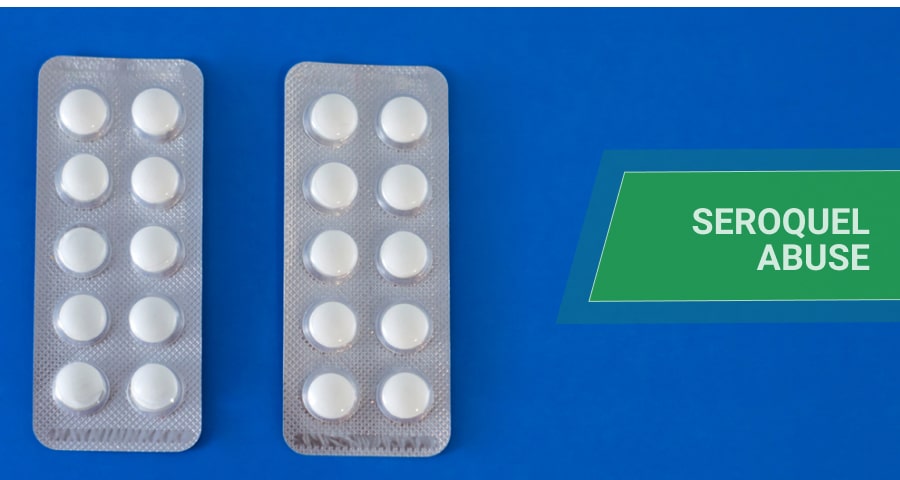
Seroquel, also known as Quetiapine, is approved for the treatment of specific mood disorders. The FDA initially approved this medication in 1997. Since then, sales of antipsychotic medicine have grown dramatically, as have the various Seroquel uses. That happened because people started taking Quetiapine Fumarate pills for off-label reasons, which are not among the common Seroquel uses and at a higher dose than average for recreational purposes.
Table Of Contents:
Among the leading causes of the drug’s abuse are taking it at a medically unapproved dose and for medically unapproved purposes. Failure to comply with the treatment schedule prescribed by the doctor and little available information on the drug’s abuse potential can also commonly lead to addiction to this drug.
So, what is Seroquel and what is it used for? Why can it be abused? Is Seroquel addictive? Read further to find out.
What Is Seroquel?
Seroquel’s drug class is called atypical antipsychotics. Drugs under this category are sold only on the prescription of a doctor. Quetiapine acts on neurotransmitters in the brain, which results in a calming effect and enhances mood. At the same time, Seroquel’s half-life is about 6 hours, and the prescribed dose should be taken several times per day to achieve a sustainable calming effect.

First released in 1997, Quetiapine has deemed a safer medication highly recommended for use among patients exhibiting high sensitivity to alternative medications like Clozapine and Olanzapine.
Like any other FDA-approved prescription medication that uses Quetiapine as a key ingredient, it has a risk of several side effects appearing. Its abuse and addiction are the other concerns to be worried about.
Although, if strictly taken at the dose and schedule prescribed by a doctor, the benefits are expected to outweigh adverse outcomes. Extra care should be taken to avoid interaction with other medications and prevent building tolerance for the drug and possible overdose.
What Is Seroquel Used For?
Quetiapine fumarate, the primary compound that gives potency to the drug, has been specifically approved in the United States and Canada to manage three specific psychiatric conditions only.
Quetiapine Was Approved by the U.S. Food and Drug Administration for the Following Uses:
- Management of schizophrenia
- Management of the bipolar disorder
- Adjunct treatment for Major Depressive Disorder
A doctor may also prescribe it for some other condition off-label. In 2010, Seroquel’s manufacturer, AstraZeneca, was even fined $520 million by the U.S. Government for allegedly marketing off-label use of the drug. Among others, it’s use for sleep was a common indication. However, according to a study by Jonathan Brett in 2015, there is insufficient information to support the drug’s efficacy for insomnia.
Seroquel For Schizophrenia
Schizophrenia is a mental illness where thoughts, emotions, and behavior do not follow a rational pattern. This lack of mental coherence results in delusions and strong and often inappropriate emotions. Quetiapine aids in managing schizophrenia by restoring a desirable balance of dopamine and serotonin.
Seroquel For Bipolar Disorder
Seroquel for bipolar depression or, more specifically, the depressive episodes of bipolar disorder is also a leading condition that prompts prescription of Quetiapine. Manic episodes of bipolar disorder and long-term maintenance treatment for bipolar disorder are also commonly treated with the antipsychotic medication.

Seroquel For Depression
The use of Seroquel for depression is recommended as an adjunct treatment. It means that the antipsychotic medication is combined with other antidepressant medications to help manage Major depressive disorder. A study has demonstrated the effectiveness of the use of Seroquel for depression and in reducing the symptoms of the condition. It was found to be effective in the treatment of mood disorders associated with mental disorders. It supported the use of Seroquel for bipolar disorder, schizophrenia, psychotic features, and other psychiatric conditions. Quetiapine works through several receptors, but its primary action is believed to be through its action on serotonin receptors. It is usually used in conjunction with other typical antidepressants to increase the treatment efficacy.
Off-Label Psychiatric Uses of the Medication
According to the National Alliance on Mental Illness (NAMI), there are also unapproved Quetiapine uses demonstrated to be beneficial and generally outweigh risks commonly associated with Quetiapine. Some of these conditions are listed below.
Seroquel For PTSD
Post-traumatic stress disorder is a psychiatric disorder that typically develops among individuals who have experienced violence or traumatic environmental events. The antipsychotic medication benefits people living with PTSD when taken as an adjunct treatment.
In a study in International Clinical Psychopharmacology, patients who had significant symptoms of PTSD were found to benefit the most when Quetiapine was added to their treatment regimen.
Seroquel For Anxiety
One of the popular Seroquel uses is the use of Seroquel for anxiety. It was explored in one study; the researchers found that Quetiapine may be beneficial for patients suffering from Generalized Anxiety Disorder (GAD). Seroquel for anxiety may be considered as alternative treatment. Despite that, the researchers cautioned that even low doses of Quetiapine to treat these conditions might lead to adverse side effects. However, another study on the use of Seroquel for anxiety showed a significant improvement in the symptoms of individuals with GAD within the first week of treatment with Quetiapine using a once-a-day dose of extended-release formulations.
Seroquel For OCD
Obsessive-Compulsive Disorder is classified as a mental health disorder where the person affected exhibits an obsession, an urge, which drives this person to act on it repeatedly.
Findings of a study published in Savvy Psychopharmacology showed that Quetiapine used for the treatment of OCD did not demonstrate significant improvements in the symptoms of individuals involved in the study. On the contrary, OCD symptoms appeared to worsen between Weeks 4 and 12 of adding Quetiapine to an OCD regimen, and there is very little information supporting its use in this condition.
Is Seroquel Addictive?
Available information on Seroquel abuse from the Substance Abuse and Mental Health Services Administration shows that of the total 1.25 million cases entertained in Emergency Departments involving drug misuse or abuse, approximately 8% involved antipsychotic medications. Of which, about half involved Quetiapine abuse.

However, Quetiapine is not considered a controlled substance due to the misguided perception that the drug has little to no dependence potential. However, several animal studies have shown that the antipsychotic has significant effects on the serotonergic and dopaminergic pathways within the brain, the brain’s reward systems. This has the potential to lead to dependence, abuse, and eventually addiction.
A possible driving force behind quetiapine abuse is the calming and hallucinogenic properties it exerts via its effects on the histaminergic, adrenergic and dopaminergic receptors. Some people also abuse quetiapine extended-release by snorting pulverized tablets or injecting the medication, which significantly increases the risk of Seroquel overdose. Other dangerous trends include combining the use of Quetiapine with alcohol, heroin, or other illicit drugs.
Also, the worrying trend of prescribing Quetiapine off-label for the treatment of insomnia has exposed patients unnecessarily to several dangerous side effects of the drug, especially when using the immediate-release formulation. Another issue with the off-label use of Quetiapine, especially without a doctor’s prescription, is the increased potential for abuse and dependence.
This has manifested as an illegal street market for the drug. Quetiapine abuse is predominant among institutionalized young males, such as those in prisons or mental health facilities.
Seroquel Abuse Signs
When Seroquel abuse is suspected, there are tell-tale signs that can help determine if there is reason to worry. These signs can be generally grouped into physical and behavioral categories.
The physical signs of quetiapine abuse typically manifest as side effects of the drug. Therefore, it may be hard to determine if the individual is experiencing the typical side effects of the drugs or the effects due to abusing the drug.
Aside from the physical signs of abuse, there are also some behavioral changes associated with quetiapine abuse. These are collectively referred to as drug-seeking behaviors.
They Include:
- Craving for the drug when not currently under its influence
- Changes in appearance or normal level of physical hygiene
- Failing performance at school or work
- Taking the medication for recreational use
- Inability to stop using the medication despite adverse health effects
- Taking the drug with other illicit drugs
- Taking the medicine while performing high-risk activities such as driving, risky sexual behaviors, extravagant spending, and so on
- Continually seeking out the drug despite the financial repercussions
- Reclusive behavior and issues with interpersonal relationships
Seroquel Addiction Treatment
Successfully overcoming this addiction requires three key steps: withdrawal and detox, drug rehab, and aftercare.
Withdrawal and Detox
Detox from this antipsychotic should never be attempted without professional help. Seroquel withdrawal symptoms are known to be severe if not managed well. The discomfort of experiencing withdrawal symptoms may also discourage a patient from continuing with treatment and therapy, which makes proper management all the more critical. Therefore taking the first step towards recovery involves seeking help at a drug rehab center.
Treatment Program In Drug Rehab
The addiction treatment approach will be different for each patient. In general, treatment for this addiction typically includes Cognitive Behavioral Therapy.

As necessary, some patients may also require medication-assisted therapy to overcome addiction to Quetiapine. At this stage, professional supervision is a must, most notably in managing other co-occurring illnesses or disorders.
Reintegration And Aftercare
A person suffering from quetiapine abuse should be eased back into society after completing a drug rehab program. Some may require longer than most to go back to daily life than others, but, in general, addiction is a life-long battle.
Individuals may benefit from halfway homes or a life coach. Some may finish their transition to sober living faster than most. What is essential is that a patient adheres to the recommendations of a professional to decrease the likelihood of regression.
Use Quetiapine Safely
Although it is not currently classified as a controlled substance, tighter restrictions should be put on the availability and use of Quetiapine due to its potential for abuse. The antipsychotic should only be used when prescribed by a doctor and only as prescribed. This reduces the chances of becoming dependent on the drug and subsequently developing an addiction to the medication.
If one feels that there are more adverse effects than benefits, or experiences too much weight gain on Seroquel, they should immediately contact a doctor. A healthcare professional will be able to determine if this treatment is appropriate and possibly change the medication.
Hope Without Commitment
Find the best treatment options. Call our free and confidential helpline
Most private insurances accepted
Find Drug Rehabilitation Centers Near You Anywhere In the US
Addiction Resource team has compiled an extensive list of the top drug rehabilitation facilities around the country. Use our locator tool to find the best centers near you.
Page Sources
- Brett, J. (2015). Concerns about quetiapine. Australian prescriber, 38(3), 95. https://www.ncbi.nlm.nih.gov/pmc/articles/PMC4653966/
- Leucht, S., Cipriani, A., Spineli, L., Mavridis, D., Örey, D., Richter, F., ... & Davis, J. M. (2013). Comparative efficacy and tolerability of 15 antipsychotic drugs in schizophrenia: a multiple-treatments meta-analysis. The Lancet, 382(9896), 951-962. https://www.ncbi.nlm.nih.gov/pubmed/23810019
- Cha, H. J., Lee, H. A., Ahn, J. I., Jeon, S. H., Kim, E. J., & Jeong, H. S. (2013). Dependence potential of quetiapine: behavioral pharmacology in rodents. Biomolecules & therapeutics, 21(4), 307. https://www.ncbi.nlm.nih.gov/pmc/articles/PMC3819904/
- Substance Abuse and Mental Health Services Administration, Drug Abuse Warning Network: National Estimates of Drug-Related Emergency Department Visits, 2011, https://www.samhsa.gov/data/sites/default/files/DAWN2k11ED/DAWN2k11ED/DAWN2k11ED.htm
- Sansone, R. A., & Sansone, L. A. (2010). Is seroquel developing an illicit reputation for misuse/abuse?. Psychiatry (Edgmont), 7(1), 13. https://www.ncbi.nlm.nih.gov/pmc/articles/PMC2848462/
- Daly, E. J., & Trivedi, M. H. (2007). A review of quetiapine in combination with antidepressant therapy in patients with depression. Neuropsychiatric disease and treatment, 3(6), 855. https://www.ncbi.nlm.nih.gov/pmc/articles/PMC2656328/
- Maneeton, N., Maneeton, B., Woottiluk, P., Likhitsathian, S., Suttajit, S., Boonyanaruthee, V., & Srisurapanont, M. (2016). Quetiapine monotherapy in acute treatment of generalized anxiety disorder: a systematic review and meta-analysis of randomized controlled trials. Drug design, development and therapy, 10, 259. https://www.ncbi.nlm.nih.gov/pmc/articles/PMC4716733/
- Bandelow, B., Chouinard, G., Bobes, J., Ahokas, A., Eggens, I., Liu, S., & Eriksson, H. (2010). Extended-release quetiapine fumarate (quetiapine XR): a once-daily monotherapy effective in generalized anxiety disorder. Data from a randomized, double-blind, placebo-and active-controlled study. International Journal of Neuropsychopharmacology, 13(3), 305-320. https://pubmed.ncbi.nlm.nih.gov/19691907/
- Cha, H. J., Lee, H. A., Ahn, J. I., Jeon, S. H., Kim, E. J., & Jeong, H. S. (2013). Dependence potential of quetiapine: behavioral pharmacology in rodents. Biomolecules & therapeutics, 21(4), 307. https://www.ncbi.nlm.nih.gov/pmc/articles/PMC3819904/


 Reviewed by:
Reviewed by:  Written by:
Written by: 

 FindTreatment.gov
FindTreatment.gov